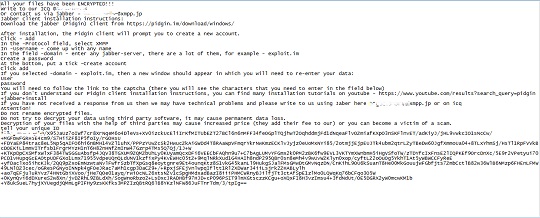Ransom.Win32.GARRANTYCRYPT.C
W32/FilecoderProt.F183!tr.ransom (FORTINET); Trojan-Ransom.Outsider (IKARUS)
Windows


Threat Type: Ransomware
Destructiveness: No
Encrypted: No
In the wild: Yes
OVERVIEW
This Ransomware arrives on a system as a file dropped by other malware or as a file downloaded unknowingly by users when visiting malicious sites.
It drops files as ransom note.
TECHNICAL DETAILS
Arrival Details
This Ransomware arrives on a system as a file dropped by other malware or as a file downloaded unknowingly by users when visiting malicious sites.
Installation
This Ransomware drops the following files:
- %Application Data%\_uninstalling_.png → contains victims unique id
- %User Temp%\{random}.tmp.jpg → image to be set as wallpaper after encryption
(Note: %Application Data% is the current user's Application Data folder, which is usually C:\Documents and Settings\{user name}\Application Data on Windows 2000(32-bit), XP, and Server 2003(32-bit), or C:\Users\{user name}\AppData\Roaming on Windows Vista, 7, 8, 8.1, 2008(64-bit), 2012(64-bit) and 10(64-bit).. %User Temp% is the current user's Temp folder, which is usually C:\Documents and Settings\{user name}\Local Settings\Temp on Windows 2000(32-bit), XP, and Server 2003(32-bit), or C:\Users\{user name}\AppData\Local\Temp on Windows Vista, 7, 8, 8.1, 2008(64-bit), 2012(64-bit) and 10(64-bit).)
It adds the following processes:
- %Windows%\sysnative\vssadmin.exe delete shadows /all /quiet
- %Windows%\sysnative\cmd.exe /c bcdedit /set {current} bootstatuspolicy ignoreallfailures
- %Windows%\sysnative\cmd.exe /c bcdedit /set {current} recoveryenabled no
- %Windows%\sysnative\cmd.exe /c netsh advfirewall set allprofiles state off
- %System%\cmd.exe /c timeout 1 && del {malware filename} >> NUL
(Note: %Windows% is the Windows folder, where it usually is C:\Windows on all Windows operating system versions.. %System% is the Windows system folder, where it usually is C:\Windows\System32 on all Windows operating system versions.)
Other System Modifications
This Ransomware sets the system's desktop wallpaper to the following image:
Process Termination
This Ransomware terminates the following processes if found running in the affected system's memory:
- msftesql.exe
- sqlagent.exe
- sqlbrowser.exe
- sqlservr.exe
- sqlwriter.exe
- oracle.exe
- ocssd.exe
- dbsnmp.exe
- synctime.exe
- agntsvc.exe
- mydesktopqos.exe
- isqlplussvc.exe
- xfssvccon.exe
- mydesktopservice.exe
- ocautoupds.exe
- agntsvc.exe
- agntsvc.exe
- agntsvc.exe
- encsvc.exe
- firefoxconfig.exe
- tbirdconfig.exe
- ocomm.exe
- mysqld.exe
- mysqld-nt.exe
- mysqld-opt.exe
- dbeng50.exe
- sqbcoreservice.exe
- excel.exe
- infopath.exe
- msaccess.exe
- mspub.exe
- onenote.exe
- outlook.exe
- powerpnt.exe
- steam.exe
- thebat.exe
- thebat64.exe
- thunderbird.exe
- visio.exe
- winword.exe
- wordpad.exe
- sqlbrowser.exe
- sqlservr.exe
- TNSLSNR.EXE
- mysqld.exe
- MsDtsSrvr.exe
- sqlceip.exe
- msmdsrv.exe
- mpdwsvc.exe
- fdlauncher.exe
- Launchpad.exe
- chrome.exe
- oracle.exe
- devenv.exe
- PerfWatson2.exe
- ServiceHubHostNodex86.exe
- Node.exe
- MicrosoftVisualStudioWebHost.exe
- Lightshot.exe
- netbeans64.exe
- spnsrvnt.exe
- sntlsrtsrvr.exe
- w3wp.exe
- TeamViewer_Service.exe
- TeamViewer.exe
- SecomSDK.exe
- schedul2.exe
- schedhlp.exe
- adm_tray.exe
- EXCEL.EXE
- MSACCESS.EXE
- OUTLOOK.EXE
- POWERPNT.EXE
- AnyDesk.exe
- Microsoft.SqlServer.IntegrationServices.MasterServiceHost.exe
- Microsoft.SqlServer.IntegrationServices.WorkerAgentServiceHost.exe
Other Details
This Ransomware does the following:
- Checks if the User uses the following languages:
- Kazakh
- Belarusian
- Tajik
- Kirghiz; Kyrgyz
- Tatar
- Azerbaijani
- Armenian
Ransomware Routine
This Ransomware avoids encrypting files with the following strings in their file name:
- #Decrypt#.txt
- _uninstalling_.png
It avoids encrypting files with the following strings in their file path:
- Windows
It appends the following extension to the file name of the encrypted files:
- .horseleader
It drops the following file(s) as ransom note:
- {Encrypted Folder}\#Decrypt#.txt

SOLUTION
Step 1
Trend Micro Predictive Machine Learning detects and blocks malware at the first sign of its existence, before it executes on your system. When enabled, your Trend Micro product detects this malware under the following machine learning name:
- TROJ.Win32.TRX.XXPE50FLM010
Step 2
Before doing any scans, Windows 7, Windows 8, Windows 8.1, and Windows 10 users must disable System Restore to allow full scanning of their computers.
Step 3
Note that not all files, folders, and registry keys and entries are installed on your computer during this malware's/spyware's/grayware's execution. This may be due to incomplete installation or other operating system conditions. If you do not find the same files/folders/registry information, please proceed to the next step.
Step 4
Search and delete this file
- %Application Data%\_uninstalling_.png
- %User Temp%\{random}.tmp.jpg
- {Encrypted Folder}\#Decrypt#.txt
Step 5
Scan your computer with your Trend Micro product to delete files detected as Ransom.Win32.GARRANTYCRYPT.C. If the detected files have already been cleaned, deleted, or quarantined by your Trend Micro product, no further step is required. You may opt to simply delete the quarantined files. Please check the following Trend Micro Support pages for more information:
Step 6
Restore encrypted files from backup.
Did this description help? Tell us how we did.



